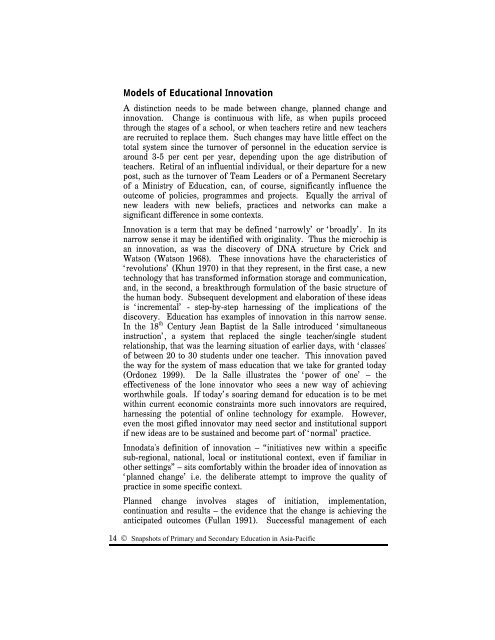Download PDF, 752KB - UNESCO Bangkok
Download PDF, 752KB - UNESCO Bangkok
Download PDF, 752KB - UNESCO Bangkok
You also want an ePaper? Increase the reach of your titles
YUMPU automatically turns print PDFs into web optimized ePapers that Google loves.
Models of Educational InnovationA distinction needs to be made between change, planned change andinnovation. Change is continuous with life, as when pupils proceedthrough the stages of a school, or when teachers retire and new teachersare recruited to replace them. Such changes may have little effect on thetotal system since the turnover of personnel in the education service isaround 3-5 per cent per year, depending upon the age distribution ofteachers. Retiral of an influential individual, or their departure for a newpost, such as the turnover of Team Leaders or of a Permanent Secretaryof a Ministry of Education, can, of course, significantly influence theoutcome of policies, programmes and projects. Equally the arrival ofnew leaders with new beliefs, practices and networks can make asignificant difference in some contexts.Innovation is a term that may be defined ‘narrowly’ or ‘broadly’. In itsnarrow sense it may be identified with originality. Thus the microchip isan innovation, as was the discovery of DNA structure by Crick andWatson (Watson 1968). These innovations have the characteristics of‘revolutions’ (Khun 1970) in that they represent, in the first case, a newtechnology that has transformed information storage and communication,and, in the second, a breakthrough formulation of the basic structure ofthe human body. Subsequent development and elaboration of these ideasis ‘incremental’ - step-by-step harnessing of the implications of thediscovery. Education has examples of innovation in this narrow sense.In the 18 th Century Jean Baptist de la Salle introduced ‘simultaneousinstruction’, a system that replaced the single teacher/single studentrelationship, that was the learning situation of earlier days, with ‘classes'of between 20 to 30 students under one teacher. This innovation pavedthe way for the system of mass education that we take for granted today(Ordonez 1999). De la Salle illustrates the ‘power of one’ – theeffectiveness of the lone innovator who sees a new way of achievingworthwhile goals. If today’s soaring demand for education is to be metwithin current economic constraints more such innovators are required,harnessing the potential of online technology for example. However,even the most gifted innovator may need sector and institutional supportif new ideas are to be sustained and become part of ‘normal’ practice.Innodata's definition of innovation – “initiatives new within a specificsub-regional, national, local or institutional context, even if familiar inother settings” – sits comfortably within the broader idea of innovation as‘planned change’ i.e. the deliberate attempt to improve the quality ofpractice in some specific context.Planned change involves stages of initiation, implementation,continuation and results – the evidence that the change is achieving theanticipated outcomes (Fullan 1991). Successful management of each14 © Snapshots of Primary and Secondary Education in Asia-Pacific
















